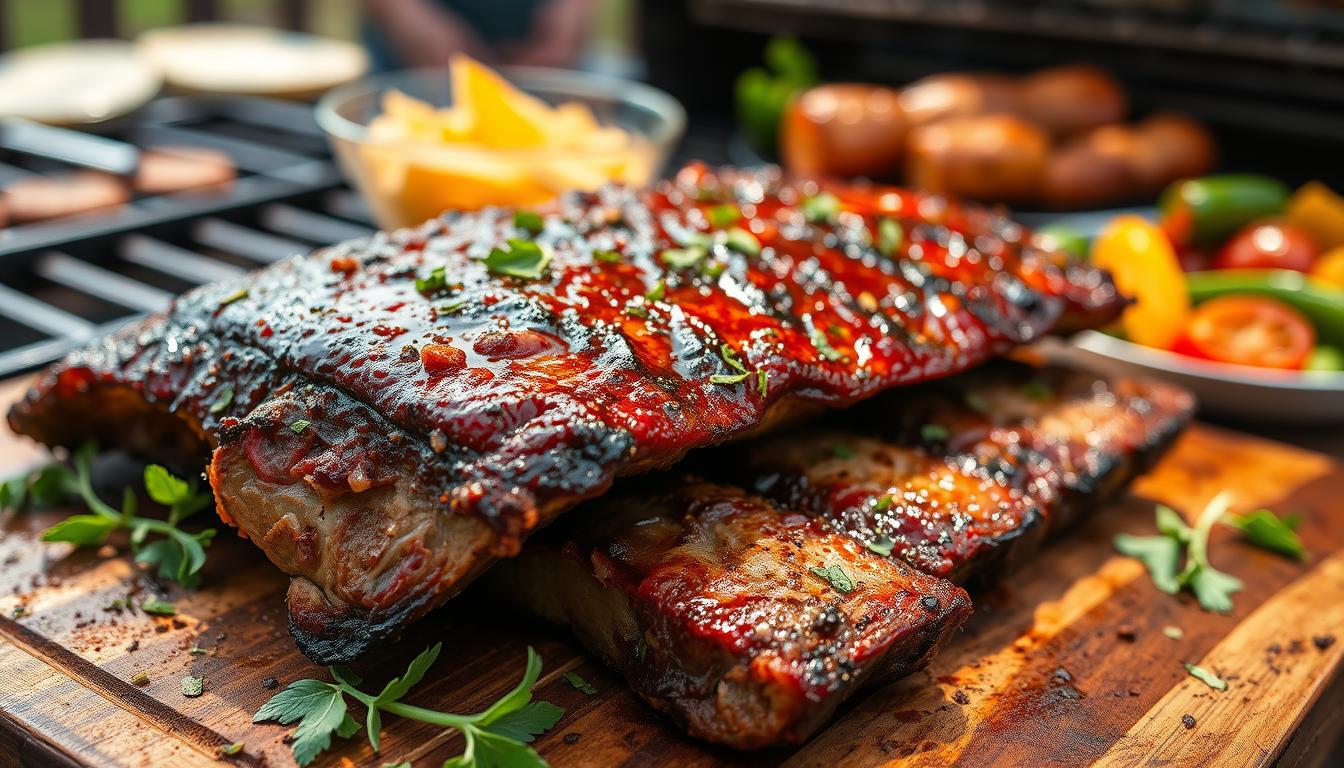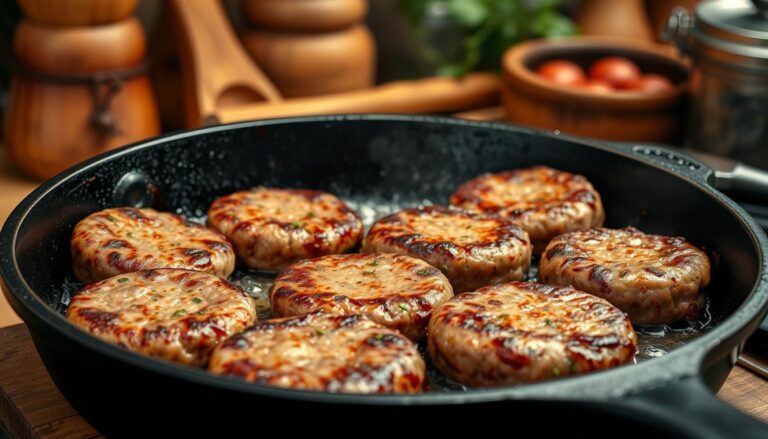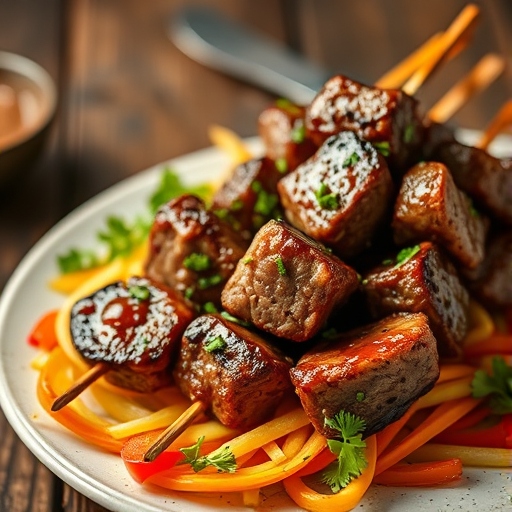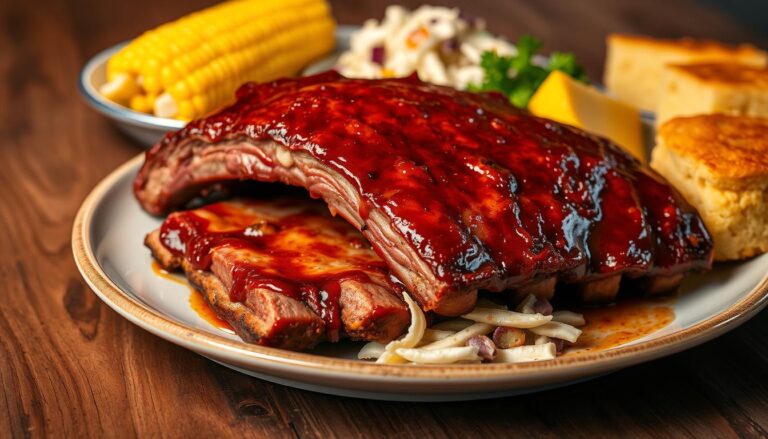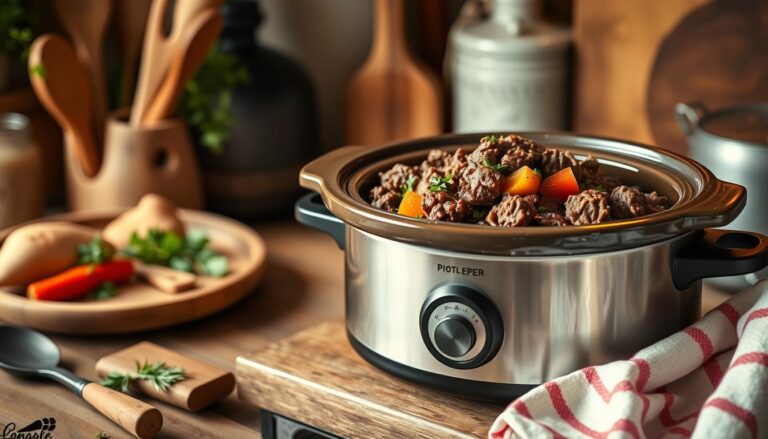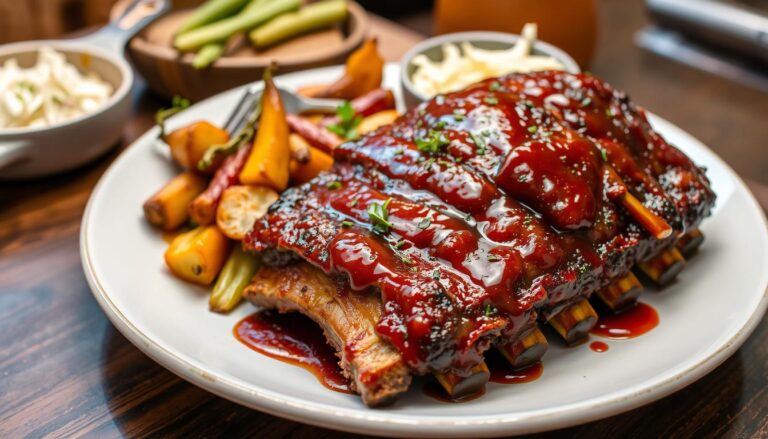Best Grilled Beef Ribs Recipe for Succulent Flavor
Are you looking for the ultimate beef ribs recipe for grilling? Get ready to take your backyard barbecue to the next level. This recipe turns tough cuts into tender, flavorful masterpieces. Grilled beef ribs are the top choice in American barbecue, offering a rich, smoky taste that will wow meat lovers.
Barbecue ribs are more than just food; they’re a work of art. Choosing the right cut, controlling the temperature, and blending spices are key to amazing flavor and texture. Whether you’re an expert griller or a weekend BBQ fan, this guide will help you make restaurant-quality ribs at home.
Table of Contents
Understanding Different Types of Beef Ribs
Exploring beef ribs can be tricky for grill lovers. Not all ribs are the same. Knowing the differences can really boost your grilling skills.
Beef ribs have several cuts, each with its own taste and cooking needs. You’ll mainly find beef back ribs and beef short ribs.
Back Ribs vs Short Ribs: A Detailed Comparison
- Beef back ribs come from the upper rib cage
- Beef short ribs are from the lower rib section
- Back ribs have 7-8 ribs per rack
- Short ribs have more meat and fat
Choosing the Right Cut for Grilling
When picking beef ribs for grilling, keep these tips in mind:
- Look for bright pink, fresh meat
- Choose cuts with even fat distribution
- Go for ribs that are the same thickness
Quality Indicators When Buying Ribs
Grill experts say to check ribs closely before buying. Look for these signs of quality:
| Indicator | Good Sign | Red Flag |
|---|---|---|
| Meat Color | Bright pink | Greyish tone |
| Fat Distribution | Even marbling | Excessive fat patches |
| Packaging | Clean, sealed | Torn or leaking |
“The secret to great beef ribs is understanding their unique characteristics and selecting the highest quality cut.” – BBQ Expert
Pro tip: Beef back ribs are leaner and great for quick grilling. Beef short ribs are best for slow-cooking, which breaks down their rich connective tissues.
Essential Equipment for Grilling Perfect Ribs
Mastering grilling techniques for barbecue ribs requires the right tools. Your equipment can make the difference between good and extraordinary ribs. Professional grill masters know that selecting the proper gear is crucial for achieving succulent, tender meat.
Let’s explore the essential equipment you’ll need for exceptional barbecue ribs:
- Grill Selection: Choose between gas or charcoal grills based on your preference and flavor profile
- Meat thermometer for precise temperature monitoring
- Heavy-duty aluminum foil for wrapping and maintaining moisture
- Basting brush for applying marinades and sauces
- Rib rack to maximize cooking space
“The right tools transform average cooking into culinary art.” – Grill Master’s Wisdom
When selecting your grilling equipment, consider these key factors for barbecue ribs:
| Equipment | Purpose | Recommended Type |
|---|---|---|
| Grill | Primary cooking surface | Gas or Charcoal with temperature control |
| Thermometer | Temperature tracking | Digital instant-read or wireless probe |
| Wood Chips | Flavor enhancement | Hickory, Apple, or Mesquite |
Investing in quality grilling equipment ensures consistent results. Your tools are the foundation of creating mouthwatering barbecue ribs that will impress family and friends.
Preparing Your Ribs Before Grilling
Getting your beef ribs ready for the grill is key. It can make or break your barbecue. Proper prep lets your dry rub get deep into the meat, making it taste amazing.
Before you start grilling, you need to turn raw beef ribs into a dish to remember. This involves a few important steps to boost your beef rib marinade.
Membrane Removal Technique
Removing the tough membrane makes ribs tender. Here’s how to do it:
- Flip the ribs bone-side up
- Use a butter knife to lift the membrane’s corner
- Grip the membrane with a paper towel for better traction
- Slowly pull the membrane away from the ribs
Trimming and Cleaning
Trimming helps ribs cook evenly and soak up more flavor:
- Trim excess fat, leaving a thin layer for moisture
- Rinse ribs under cold water
- Pat dry with paper towels
- Inspect for any remaining silver skin
Dry Rub Application Methods
Learning to apply dry rub is crucial. Generously coat the entire surface for even flavor. Rub the dry rub into the meat to create a flavorful crust that caramelizes while grilling.
“The secret to incredible ribs is in the preparation and seasoning.” – Barbecue Experts
For the best taste, let your seasoned ribs rest in the fridge for 2-12 hours. This lets the dry rub soak deep, making the ribs rich and complex. Your guests will love it.
Ultimate Beef Ribs Recipe Grill Guide
Grilling the perfect beef ribs needs precision and skill. Your journey to grilling great beef ribs starts with knowing the key steps. These steps turn regular meat into a tasty treat.
Picking the right cut is key for your grilled beef ribs. Back ribs are 3-4 pounds and feed 1½ pounds per person. They’re perfect for parties. Each pound gives you 2 to 2.5 ribs, so a 4-pound portion yields about 10 ribs.
Grilling Preparation Checklist
- Choose Prime or Choice grade beef ribs
- Ensure grill temperature stays between 250-275°F
- Plan for 1.5 to 2 hours total cooking time
- Target internal temperature of 190°F
“Perfect grilled beef ribs are about patience and precision” – BBQ Masters
Cooking Method
Your beef ribs recipe grill technique should be low and slow. Start by heating your grill to a steady 250°F. Place ribs bone-side down on the grates for even heat.
| Cooking Stage | Temperature | Time |
|---|---|---|
| Initial Grilling | 250°F | 1-1.5 hours |
| Wrapping Phase | 250°F | 30-45 minutes |
| Final Caramelization | 275°F | 15-30 minutes |
Pro tip: Wrap ribs in butcher paper during cooking to lock in moisture and create tender, succulent meat.
Finishing Touches
In the last 30 minutes, brush your ribs with homemade BBQ sauce. This adds a tasty caramelized layer. Let the ribs rest for at least 30 minutes before serving. This ensures they are tender and juicy.
Creating the Perfect Dry Rub Blend
Making a great dry rub for ribs turns simple meat into a feast for the taste buds. Your homemade mix can make beef ribs taste amazing. It’s sure to wow your family and friends.
A top-notch dry rub for ribs mixes sweet, spicy, and savory flavors. It’s all about knowing how spices work together.
Essential Spices and Measurements
Creating the perfect dry rub for ribs needs careful picking of ingredients. Here’s a top recipe for amazing results:
- 2 tablespoons kosher salt
- 1 tablespoon chili powder
- 1 tablespoon garlic powder
- 1 tablespoon light brown sugar
- 1 tablespoon onion powder
- 1 tablespoon paprika
- 2 teaspoons ground cumin
- 2 teaspoons ground mustard
- 1 teaspoon ground black pepper
- ½ teaspoon cayenne pepper
Storage and Shelf Life Tips
Keeping your dry rub fresh is key. Store it in a sealed container at room temperature. Keep it away from sunlight and moisture. It stays flavorful for three to four months, but can last up to six.
“A well-crafted dry rub is like a signature—unique, personal, and unforgettable.” – Grilling Enthusiast
Play with the mix to make your own special dry rub for ribs. About 2 tablespoons per rack of ribs is just right.
Pro tip: Always apply the dry rub at temperatures below 265°F to prevent burning, especially due to the sugar content.
Mastering the Art of Temperature Control
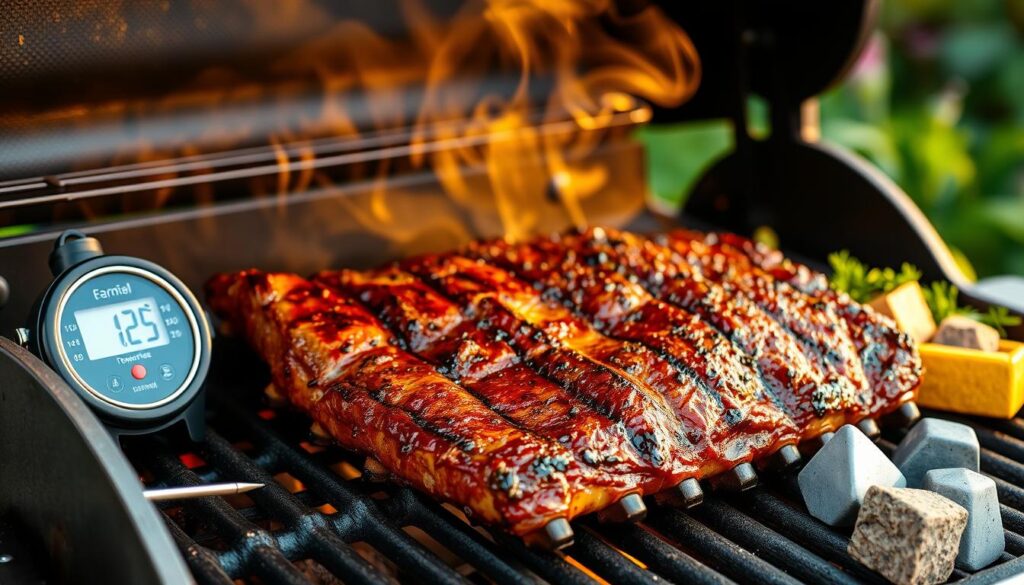
Perfecting your grilling techniques means mastering temperature control. Every great pitmaster knows that precise heat control can turn ordinary meat into a culinary masterpiece.
For beef ribs, temperature is key. The low and slow method is best, with temperatures between 225°F and 275°F.
“Temperature control is the difference between good barbecue and great barbecue” – BBQ Expert
Grill Temperature Strategies
- Create a two-zone fire setup for optimal heat management
- Use indirect heat to prevent burning
- Monitor grill temperature consistently
- Adjust vents to control oxygen flow
| Cooking Method | Temperature Range | Typical Cooking Time |
|---|---|---|
| Low and Slow | 225°F – 275°F | 4-6 hours |
| Hot and Fast | 350°F – 450°F | 2-4 minutes per side |
Your thermometer is crucial. Get a reliable digital thermometer to track temperatures. This ensures your beef ribs are tender and succulent.
Different fuels affect temperature control. Lump charcoal burns hotter, while briquettes offer consistent heat. Try different fuels to find your best grilling method.
Smoking Techniques for Enhanced Flavor
Smoking turns regular beef ribs into a true culinary delight. The right method can take your grilling to the next level. It makes your ribs so good, even the toughest critics will be impressed.
To master smoked beef ribs, you need to know about wood and smoke control. The wood you pick greatly affects the taste of your ribs.
Selecting the Perfect Smoking Woods
Not all woods are good for smoking beef ribs. Your choice can either make or break the dish.
- Oak: Provides a medium-strong flavor perfect for beef
- Pecan: Offers a subtle, sweet smoke profile
- Hickory: Delivers a classic, bold barbecue taste
- Mesquite: Intense flavor best used sparingly
Developing the Ideal Smoke Ring
The smoke ring is a pink layer under the meat. It shows you’re a pro at smoking. To get it, you need to control the temperature and pick the right wood.
| Wood Type | Flavor Intensity | Best Used With |
|---|---|---|
| Oak | Medium | Beef Ribs |
| Pecan | Mild | Beef Ribs |
| Hickory | Strong | Beef Ribs |
“The secret to great smoked beef ribs is patience and understanding your smoke’s character.” – BBQ Pitmaster
Pro tip: Keep the smoke thin and blue for the best flavor. Thick white smoke can make your ribs taste bitter.
Recommended Smoking Temperature: 225°F (107°C)
Basting and Glazing Strategies
Turning your beef rib marinade into something amazing needs the right basting and glazing techniques. These methods can make your barbecue ribs go from good to great. They become so delicious that everyone wants more.
Grill masters know basting is more than just adding moisture. It’s about adding layers of flavor. Your marinade should mix well with the meat’s natural taste.
“Balancing smoke, spice, heat, and time creates remarkable tenderness and complex flavor in ribs.” – Steven Raichlen, Barbecue Expert
Basting Liquid Components
- Apple cider vinegar
- Hot sauce
- BBQ sauce blend
- Worcestershire sauce
- Olive oil
Timing is everything when cooking barbecue ribs. Baste every 30-45 minutes. This keeps the ribs juicy and adds a sweet, caramelized outside.
Glazing Techniques
- Brush thick BBQ sauce during final 15-30 minutes
- Allow sauce to caramelize without burning
- Avoid sugar-based sauces early in cooking process
| Basting Stage | Technique | Purpose |
|---|---|---|
| Early Cooking | Thin, liquid-based baste | Moisture retention |
| Mid Cooking | Vinegar-based mixture | Flavor enhancement |
| Final Stage | Thick BBQ glaze | Caramelization |
Remember, patience and precision are key when basting your beef rib marinade. The goal is to create barbecue ribs that are tender, flavorful, and visually stunning.
Testing for Doneness and Tenderness
Perfectly grilled beef ribs need careful techniques to reach mouth-watering perfection. Knowing how to check your ribs makes grilling better than ever.

Temperature Guidelines for Grilled Beef Ribs
Internal temperature is key when grilling beef ribs. Experts say to aim for 195°F to 203°F for the best tenderness.
- Use a digital meat thermometer
- Check the thickest part of the meat
- Avoid touching the bone when measuring
Visual Doneness Indicators
Visual signs also show if your ribs are done. Look for these signs:
- Meat pulling back from the bone by about 1/4 inch
- Dark, caramelized exterior
- Meat that bends easily when lifted with tongs
“The secret to great grilled beef ribs is patience and precise temperature control.” – Grill Master Chef
The Bend Test Technique
The “bend test” is a classic way to check ribs. When you lift the rack with tongs, it should flex slightly and start to crack. This means the connective tissues have broken down, making the ribs tender.
Don’t forget about carryover cooking during rest time. It can raise the internal temperature by 5-10 degrees.
Resting and Serving Your Ribs
After hours of careful preparation, your barbecue ribs need a proper resting period. This step is crucial. It turns good ribs into exceptional ones by letting the meat’s juices spread out evenly.
The best resting time for barbecue ribs is between 10-15 minutes. During this time, cover the ribs loosely with aluminum foil. This keeps the heat and moisture in. It makes sure each bite is succulent and tender.
“Patience is the secret ingredient that turns great barbecue ribs into unforgettable culinary experiences.”
Serving Recommendations
- Use a sharp knife to cut between the bones
- Arrange ribs on a large decorative platter
- Garnish with fresh herbs like parsley or cilantro
- Provide additional BBQ sauce on the side
When serving your barbecue ribs, how you present them is as important as the taste. A well-arranged platter can make the whole dining experience better.
Storage and Reheating Tips
| Storage Method | Duration | Reheating Temperature |
|---|---|---|
| Refrigerator | 3-4 days | 325°F for 15-20 minutes |
| Freezer | 2-3 months | Thaw overnight, then reheat |
Pro tip: Always cover ribs with foil when reheating. This prevents moisture loss and keeps their delicious texture.
Complementary Side Dishes and Pairings
Adding the right side dishes can make your barbecue ribs meal unforgettable. Choose a mix of classic and new sides to balance the flavors. This will make your meal stand out.
Classic Side Dish Lineup
- Creamy Potato Salad with a tangy mustard base
- Southern-style Collard Greens with a vinegary kick
- Honey Lime Grilled Corn
- Cornbread Muffins
- Baked Beans with reduced sugar
For barbecue ribs, it’s all about texture and flavor. A crisp coleslaw can balance the meat’s richness. Creamy mac and cheese adds comfort, while grilled veggies are a lighter choice.
Beverage Pairings
“The right drink can elevate your barbecue ribs from great to extraordinary.”
- Craft Beer
- Full-bodied Red Wine
- Sweet Iced Tea
- Citrus-infused Lemonade
Don’t forget dessert! A fresh watermelon or a light fruit cobbler is perfect after ribs. Aim for a meal that excites every taste bud.
Conclusion
Grilling beef ribs is an art that needs patience, practice, and passion. Your journey to making delicious grilled beef ribs starts with learning the right techniques. These techniques turn simple meat into a special culinary experience.
By following the tips and strategies in this guide, you’ll get better at trying different flavors and cooking methods. This will help you grow more confident in your grilling skills.
The art of grilling beef ribs is not just about cooking. It’s about making a meal that people will remember. Every time you grill, you’ll get better at controlling the temperature and picking the right wood chips.
You’ll also learn how to make a dry rub that shows off your taste. Remember, the secret to great grilled beef ribs is in the preparation, technique, and learning from each try.
As you keep exploring grilling, don’t be scared to try new things. Experiment with marinades and different smoking woods like hickory or oak. Adjust your techniques based on the ribs you’re using.
With time, you’ll know how to make tender, tasty ribs that will wow your family and friends at barbecues. Your grilling journey is just starting. Each rack of ribs is a chance to get better, try new flavors, and make tasty memories around the grill.
Keep trying new things, stay curious, and enjoy the journey to becoming a true barbecue master.
FAQ
What are the different types of beef ribs available for grilling?
How long should I cook beef ribs on the grill?
Do I need to remove the membrane from beef ribs?
What’s the best way to add flavor to beef ribs?
How do I know when my beef ribs are done?
Can I prepare beef ribs in advance?
What are the best wood chips for smoking beef ribs?
How should I rest my beef ribs after grilling?
Source Links
- The Best Mouthwatering Fall-Off-The-Bone BBQ Ribs Recipe – https://chefjeanpierre.com/recipes/mains/easy-bbq-ribs-recipe/
- Beef Back Ribs Recipe – Healthy Recipes Blog – https://healthyrecipesblogs.com/oven-beef-back-ribs/
- Barbecue Beef Short Ribs – https://www.slapyodaddybbq.com/2024/04/barbecue-beef-short-ribs/
- Three Little Pigs BBQ & Catering – https://three-little-pigs-bbq.com/dev/help-i-need-to-know-what-cut-of-beef-ribs-to-tell-my-butcher/
LEAVE A COMMENT
Have a question? Use the form below to submit your question or comment. I love hearing from you & seeing what you made!
There are no reviews yet. Be the first one to write one.

